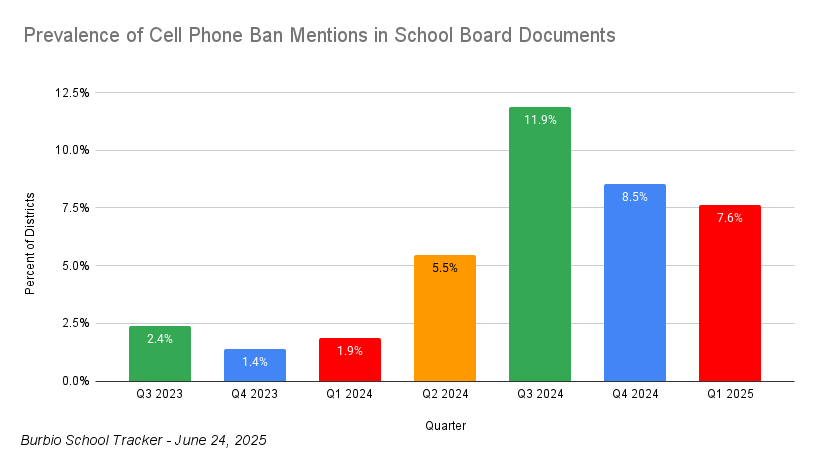1. Burbio's school board meeting minute database contains everything from policy trends to highly specific, contextual answers about district initiatives through our Signals Tracker. With the continued expansion of cell phone bans in school districts, this week we look at the increase in mentions of the terms cell phone policy, cell phone ban, phone ban, and phone-free school in school board meetings. The following chart shows the percentage of districts that mention these terms at least once in the indicated quarter. We note the increase in mentions beginning in the July-September, back-to-school period of this past school year: 
2. Burbio is rolling out a state-level policy dashboard for all fifty states plus the District of Columbia. This will supplement our current State Grants Dashboard and is particularly relevant given the changing role of the Federal Government in education. This week we highlight recent activity at State Board of Education meetings, which will be included in the dashboard.
Individual state board meetings can vary in significance. Some feature only proclamations, administrative updates, and awards ceremonies, but others involve issues of more urgency to suppliers such as curriculum adoption, standards reviews, the creation of grants, and budget issues. Examples of recent meeting topics from across the U.S. include:
Curriculum and Standards:
- South Dakota recently adopted new K-8 Computer Science and English Language Arts Standards.
- In Maryland, the state discussed the roll out of revised PreK-8 math standards, set for the 2026-27 school year.
- In Iowa, the state adopted revised science standards.
Grants:
- In Colorado last month the board approved over $1 million of Early Literacy Grants to eight school districts, and in June approved $127 million in BEST grants for school security.
- In Arkansas, the state's Office of Early Childhood received approval for two Professional-service themed grants of almost $17 million.
Administrative and Budgeting:
- In Massachusetts, a recent meeting discussed a proposed increase in CTE funding in the state, along with revised regulations governing applications to CTE programs.
- In a recent Florida meeting the board discussed the 2025-26 education budget, citing "the budget allocates $565 million for school safety initiatives, including $300 million for safe schools, $190 million for mental health," and additional spending initiatives.
We are excited to expand our state-level surveillance and will provide additional trends in future Trackers.
3. Burbio's Signals Tracker uses AI to provide highly specific, contextual answers across a wide range of school operations, from policy setting to purchase decisions. One of the questions we get frequently is identifying district discussions of school improvement plans. These plans often highlight initiatives that represent inflection points of district activity. Some examples from around the country across a variety of categories:
- In Effingham County Schools, GA, school principals presented improvement plans for their respective middle schools, focusing on data-driven instruction, targeted student support and professional development.
- In Renton School District 403, WA, the Deputy Superintendent, along with the Director of Curriculum, highlighted data-driven strategies to strengthen K–2 literacy, deepen grades 3–8 math engagement, and improve 9th grade success through targeted interventions and professional learning, going into details on all three initiatives.
- Norwalk School District, CT, discusses focus areas including AI professional learning, leadership effectiveness initiatives for staff, improving indoor air quality, and certification status tracking for teachers.
We also pick up broader signals around district improvement, often containing specific details:
- Lancaster ISD, TX, a STEM-focused district, gave a quarterly update on their District Improvement Plan, detailing initiatives across MTSS, SEL, technology, and special education.
- Okemos Public Schools, MI, presented district data across all academic areas, with specific targets and implementation steps, including in math, ELA, and professional development.